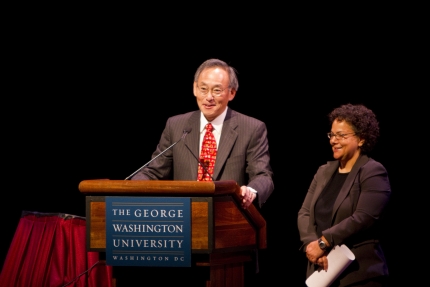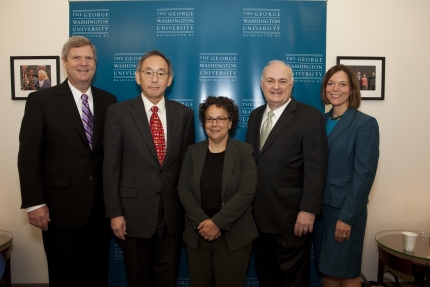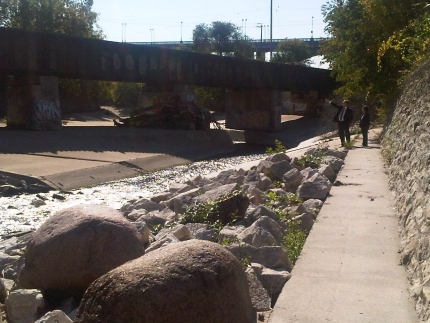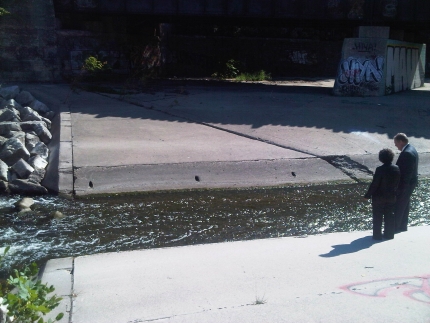Council on Environmental Quality Blog
Saving Homeowners Money and Creating Jobs
Posted by on November 9, 2010 at 7:37 PM EDTI was thrilled to take part in the Vice President’s Middle Class Task Force event at the White House today announcing home energy efficiency measures that will achieve real cost savings and environmental benefits for American families. Among the announcements was the creation of a voluntary Home Energy Score program from the Department of Energy that will provide families with clear, reliable and customized information about their home’s energy efficiency. This means that homeowners who are considering energy retrofits will have an easy way to make cost-effective decisions about energy upgrades. (See a sample of the Home Energy Score below.)
The Home Energy Score and the other measures we announced today are designed support the growth of a strong, self sustaining home energy efficiency industry in the United States. They also get to the heart of the Recovery Through Retrofit initiative, which focused on ways to help save Americans money on their electricity bills while growing job opportunities here at home.
At the White House meeting, I was proud to look around and see how many people have been involved in this initiative and have been working together for 18 months to make these programs a reality for American homeowners. Today was just the beginning. We will continue to pursue ideas that make sense for our economy, for our environment, and for America’s middle class.
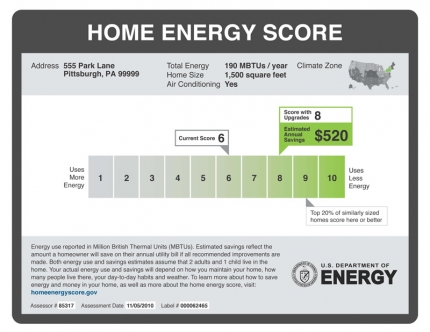
November 10, 2010.
Nancy Sutley is Chair of the White House Council on Environmental Quality
Learn more about Energy and EnvironmentA Discussion on Clean Energy in Missoula
Posted by on October 22, 2010 at 11:42 AM EDTLast weekend I traveled to beautiful Missoula, Montana, to engage in a lively panel conversation about America’s energy future at the 20th Annual Conference for the Society of Environmental Journalists (SEJ). The conference, hosted by the University of Montana, drew journalists from across the country who focus on essential issues affecting our environment, and who were eager to discuss efforts underway to grow the clean energy economy.
Promoting a sustainable, clean energy economy that creates jobs is a priority for this Administration. We have shown our commitment through a $90 billion Recovery Act investment in renewable energy, and setting new fuel-economy and greenhouse gas emissions standards for vehicles, among other critical measures. We’re also leading by example by setting ambitious sustainability goals for Federal Agencies for energy efficiency, reducing greenhouse gas pollution, conserving water, and promoting sustainable communities.
Open conversations like the one we had at SEJ are crucial as we confront today’s environmental and economic challenges. Engaging people with a range of views and backgrounds helps us to achieve a shared vision of a healthy and prosperous future for the U.S. I left Missoula optimistic about America’s potential to seize the opportunity of clean energy.
Nancy Sutley is Chair of the White House Council on Environmental Quality
Learn more about Energy and EnvironmentIowa Conservation Partnerships
Posted by on October 21, 2010 at 6:29 PM EDTOn Monday, I joined USDA Deputy Under Secretary for Natural Resources and Environment Ann Mills and USDA Legislative Director Tina May in Iowa to meet with the Iowa Soybean Association (ISA) and learn about their partnership-based efforts to support natural resource conservation. ISA is working with its members on a number of programs to enhance water quality. During our visit, we had the chance to see an on-farm water quality monitoring station and learn how farmers are reducing nitrate loading in the Boone River watershed. We also met with a farmer who has implemented strip-till practices and installed a bioreactor on his land, both of which help bolster watershed water quality. The trip certainly helped to further my understanding of on-farm energy use and the opportunities available in this arena. The visit to Iowa was educational, and I look forward to learning more about the energy and environmental initiatives of ISA and other agriculture organizations. It was a terrific experience!
Jess Maher is the Associate Director for Legislative Affairs at the White House Council on Environmental Quality
Learn more about Energy and EnvironmentUnderstanding, Preparing and Responding to Climate Change
Posted by on October 14, 2010 at 3:26 PM EDTI am proud that the Interagency Climate Change Adaptation Task Force released a report today with recommendations that will help strengthen the Nation’s capacity to understand, prepare for, and respond to the risks associated with climate change. The Task Force, co-chaired by the Council on Environmental Quality, the Office of Science and Technology Policy, and the National Oceanic and Atmospheric Administration, includes representatives from more than 20 Federal Agencies that collaborated on these recommendations at the request of the President (you can view the report here).
We know that climate change is already affecting communities, livelihoods and natural places around the world. Curbing greenhouse gas emissions to reduce the effects of climate change is a priority. The Federal Government also has an obligation to prepare for and respond to the risks and vulnerabilities we are already beginning to see, and the impacts we may see in the future.
The Federal Government must consider how climate risks will affect our services, operations and assets throughout the country. Infrastructure such as Federal roads, for example, may require additional resilience to extreme heat, extreme cold, or more frequent and severe floods. Public lands may need to be managed to take into account more frequent or severe droughts and wildfires. Planning for adaptation will reduce the long-term costs of responding to these kinds of impacts, and help protect American communities and the infrastructure and natural areas they rely on.
The Federal Government can also play a critical role in building greater awareness of the importance of adaptation, promoting best practices, and providing access to essential information about climate risks and vulnerabilities. The recommendations we announced today will help ensure the United States is prepared to safeguard our citizens, our communities and our economy as we confront the 21st century challenge of global climate change.
Nancy Sutley is Chair of the White House Council on Environmental Quality
Learn more about Energy and EnvironmentCommitment to Lead: Solar on the White House
Posted by on October 5, 2010 at 11:48 AM EDTWe kicked off the first annual GreenGov Symposium today at George Washington University with more than 1,000 attendees, and keynotes from U.S. Department of Energy Secretary Steven Chu, U.S. Department of Agriculture Secretary Tom Vilsack and Janine Benyus, president of The Biomimicry Institute and co-founder of the Biomimicry Guild. Secretary Chu and I had the honor of announcing plans to install solar panels and a solar hot water heater on the roof of the White House Residence, a project that demonstrates American solar technologies are available, reliable, and ready for installation in homes throughout the country.
It was just one year ago today that President Obama signed an Executive Order asking the Federal Government to look inward and push ourselves to operate more sustainably. He asked us to set, and then meet, some aggressive goals, and to leverage our assets, our purchasing power, and our large and dedicated work force to help advance clean energy opportunities, cut the pollution that is degrading our planet, and save American taxpayer dollars in the process. Agencies across the Federal Government are excited and proud of what they are doing and what they intend to do to live up to the promise of GreenGov.
Over the next few days, the Symposium will cover a broad range of topics including clean energy, water efficiency, achieving zero waste, greening the supply chain, and sustainable communities. To view the complete workshop agenda, visit: www.whitehouse.gov/greengov/symposium
Nancy Sutley is Chair of the White House Council on Environmental Quality
Learn more about Energy and EnvironmentInvesting in the Health of the Great Lakes
Posted by on September 29, 2010 at 7:25 PM EDTI spent Monday morning in Milwaukee touring the impressive work underway to integrate the natural environment back into water infrastructure. Throughout the tour, I saw ways in which the Milwaukee Metropolitan Sewerage District (MMSD) is using or planning to use green infrastructure to manage and reuse stormwater, reducing pollution in the Great Lakes in a more natural way. I was proud to announce that we are awarding MMSD a $4 million grant through the Great Lakes Restoration Initiative to continue this type of innovative and effective restoration work.
President Obama created the Great Lakes Restoration Initiative to target the most significant problems facing the Great Lakes, and track progress in addressing them. Through this initiative, we have proposed the largest investment in the Great Lakes in two decades. The grant awarded to the Milwaukee Metropolitan Sewerage District will fund projects to help meet these restoration goals.
The Great Lakes support a multi-billion dollar economy, provide drinking water for 30 million people, and help shape the culture and environment of the region. But just like many of our nation’s ecosystems, the Great Lakes face challenges like pollution, invasive species, habitat loss and environmental degradation that threaten to erode them. The Great Lakes Restoration Initiative calls for aggressive action to address priority areas such as cleaning up toxics and toxic hot spots, combating invasive species, protecting watersheds from polluted run-off, and restoring wetlands and other habitats.
Restoring the Great Lakes is a national priority. Working together, we can protect this magnificent resource for the benefit of Great Lakes communities and all Americans.
Nancy Sutley is Chair of the White House Council on Environmental Quality
Learn more about Energy and Environment
- &lsaquo previous
- …
- 29
- 30
- 31
- 32
- 33
- 34
- 35
- 36
- 37
- …
- next &rsaquo
White House Blogs
- The White House Blog
- Middle Class Task Force
- Council of Economic Advisers
- Council on Environmental Quality
- Council on Women and Girls
- Office of Intergovernmental Affairs
- Office of Management and Budget
- Office of Public Engagement
- Office of Science & Tech Policy
- Office of Urban Affairs
- Open Government
- Faith and Neighborhood Partnerships
- Social Innovation and Civic Participation
- US Trade Representative
- Office National Drug Control Policy
categories
- AIDS Policy
- Alaska
- Blueprint for an America Built to Last
- Budget
- Civil Rights
- Defense
- Disabilities
- Economy
- Education
- Energy and Environment
- Equal Pay
- Ethics
- Faith Based
- Fiscal Responsibility
- Foreign Policy
- Grab Bag
- Health Care
- Homeland Security
- Immigration
- Innovation Fellows
- Inside the White House
- Middle Class Security
- Open Government
- Poverty
- Rural
- Seniors and Social Security
- Service
- Social Innovation
- State of the Union
- Taxes
- Technology
- Urban Policy
- Veterans
- Violence Prevention
- White House Internships
- Women
- Working Families
- Additional Issues


